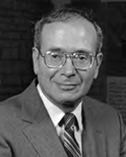Nationality American Academic advisor Maurice Ewing | Name Frank Press Role Geophysicist | |
 | ||
Born December 4, 1924 (age 100) Brooklyn, New York,United States ( 1924-12-04 ) Alma mater City College of New York (B.S.) (1944)Columbia University (M.S.) (1946)Columbia University (Ph.D)(1949) Notable awards Awards Gold Medal of the Royal Astronomical Society, Arthur L. Day Medal, National Medal of Science for Physical Science | ||
My challenge to zakir naik dr frank press mountains
Frank Press (born December 4, 1924) is an American geophysicist. He was an advisor to four U.S. Presidents, and later served two consecutive terms as President of the U.S. National Academy of Sciences (1981–1993). He is the author of 160 scientific papers and co-author of the textbooks Earth and Understanding Earth.
Contents
- My challenge to zakir naik dr frank press mountains
- Frank Press Quotes
- Early life and career
- Later career
- Notable accomplishments
- Awards
- Publications
- References
Press served on President's Science Advisory Committee during the Kennedy and Johnson administrations, and was appointed by President Richard Nixon to the National Science Board. In 1977 he was appointed President Jimmy Carter's Science Advisor and Director of the Office of Science and Technology Policy, serving until 1981.
Frank Press Quotes
Early life and career
Born in Brooklyn, New York, Press graduated with a B.S. degree from the City College of New York (1944) and completed his M.A. (1946) and Ph.D. (1949) degrees at Columbia University under Maurice "Doc" Ewing. As one of Ewing's two assistant professors, (with J. Lamar "Joe" Worzel as the other) Press was a co-founder of Lamont Geological Observatory (now Lamont-Doherty Earth Observatory) in Palisades, N.Y. Originally trained as an oceanographer, Press participated in research cruises on the sailing vessels RV Vema and RV Atlantis.
In the early 1950s, Press turned to seismology, co-authoring with Ewing and Jardetzky a seminal monograph on elastic waves in layered media. In 1957, Press was recruited by Caltech to succeed founder Beno Gutenberg as director of the Seismological Laboratory, a position in which he remained until 1965. The appointment was controversial in that it passed over both Hugo Benioff and Charles Richter, then the laboratory's senior professors, for a much younger outsider.
Press' accomplishments in this period include the design of a long-period seismograph, and the first detection of the Earth's normal modes of oscillation ("bell ringing"), excited by the Great Chilean earthquake, a pioneering application of digital processing to seismic recordings. Press was also closely involved in the construction of a lunar seismograph, first deployed by the Apollo 11 astronauts (see Lunar seismology).
Later career
In 1965, Press moved to MIT as department head of Earth and Planetary Sciences, where, with significant support from philanthropist Cecil H. Green, he revitalized what had been an overly traditional geology department by hiring new faculty members. He remained at MIT until 1976, and during this time, his work included collaborations with Vladimir Keilis-Borok and Leon Knopoff on computer pattern matching techniques that could be applied to earthquake prediction.
In 1976, Press became Science Advisor to President Jimmy Carter and director of the Office of Science and Technology Policy. In 1981 he was elected president of the U.S. National Academy of Sciences and was re-elected in 1987, serving for a total of 12 years.
In 1996, Press co-founded WAG (the Washington Advisory Group, later known as the Advisory Group at Huron), a global consulting company with clients that included approximately 50 leading universities. WAG played a notable role all phases of the founding of King Abdullah University of Science and Technology (KAUST) in Thuwal, Saudi Arabia. Press chaired that university's international advisory committee until 2010.
Press is the recipient of 30 honorary degrees. Named in his honor are Mount Press, which in the Ellsworth Mountains, Antarctica; and Osedax frankpressi, a species of whalebone-eating marine worm.
